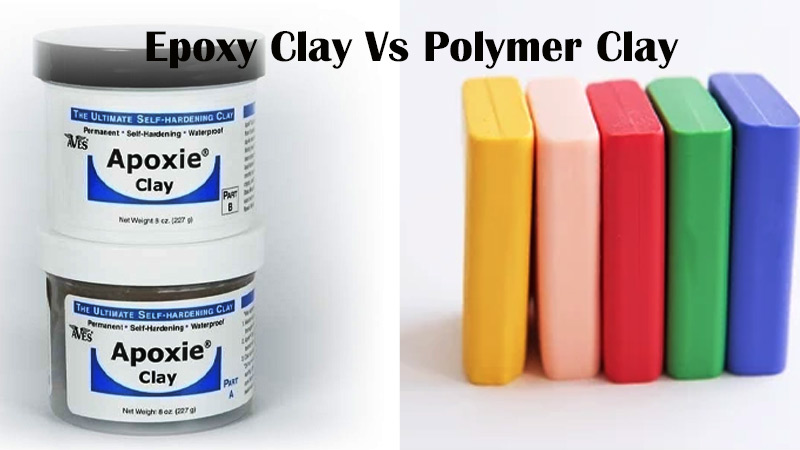Sculpting offers boundless creative avenues, with various mediums catering to diverse needs. Two prominent options are epoxy clay and polymer clay, each presenting distinct advantages and limitations.
This comprehensive guide explores the characteristics, benefits, and drawbacks of both, empowering you to make an informed decision based on your specific sculpting needs.

Understanding Epoxy Clay
Epoxy clay is a two-part compound consisting of a resin and a hardener. When mixed, a chemical reaction occurs, causing the clay to harden over time.
This air-drying process eliminates the need for baking, making it ideal for sculpting on objects that cannot withstand high temperatures.
Key Features of Epoxy Clay
- Strong Adhesive Properties: Epoxy clay acts like glue, allowing direct application and adherence to various surfaces, including metal, plastic, and wood. This property expands creative possibilities by enabling sculpting directly onto existing objects.
- Air-Drying: Unlike polymer clay, epoxy clay hardens at room temperature, eliminating the risk of damaging heat-sensitive materials during the curing process.
- Exceptional Strength: Epoxy clay boasts superior strength and durability compared to polymer clay, making it suitable for intricate detailing and creating sturdy sculptures.
- Paintable Surface: While primarily available in neutral colors, epoxy clay readily accepts paints, stains, and other finishes, providing ample customization options.
Advantages of Epoxy Clay
- Versatile Application: Its adhesive nature allows for sculpting on various surfaces, including those unsuitable for baking.
- Convenience of Air-Drying: No oven required, simplifying the sculpting process and expanding creative opportunities.
- Enhanced Durability: The hardened clay is strong and resistant to breakage, making it suitable for intricate details and creating robust sculptures.
Drawbacks of Epoxy Clay
- Limited Color Options: Primarily available in neutral shades, requiring painting for achieving desired colors.
- Working Time Constraints: Once mixed, the clay has a limited working time before hardening, necessitating efficient sculpting.
- Potential Stickiness: Epoxy clay can be very sticky, requiring the use of gloves, tools, and a silicone mat to prevent it from sticking to hands and surfaces.
Understanding Polymer Clay
Polymer clay is a modeling clay made from polyvinyl chloride (PVC). It becomes pliable when heated and hardens upon cooling after baking in a conventional oven.
Polymer clay is known for its versatility, wide array of colors, and compatibility with various sculpting techniques.
Key Features of Polymer Clay
- Wide Range of Colors: Available in a vast spectrum of colors, eliminating the need for painting unless desired.
- Versatility: Allows for various sculpting techniques, including caning, marbling, and creating translucent effects.
- Easy Workability: Polymer clay is pliable and easy to manipulate, offering a forgiving learning curve for beginners.
- Baking Required: Hardens upon baking in a conventional oven, ensuring lasting durability and shape retention.
Advantages of Polymer Clay
- Colorful Creations: Offers a diverse palette of colors, simplifying the creative process.
- Technique Versatility: Supports various sculpting techniques for achieving unique textures and effects.
- Beginner-Friendly: The pliable nature of polymer clay makes it easy to work with, ideal for beginners.
Drawbacks of Polymer Clay
- Baking Limitations: The need for baking restricts its use on objects that are not oven-safe.
- Potential for Breakage: While durable, polymer clay can be more prone to breakage compared to epoxy clay.
- Color Mixing Time: Achieving specific colors might require extensive mixing and conditioning, which can be time-consuming.
Epoxy Clay vs. Polymer Clay: A Comparative Table
| Feature | Epoxy Clay | Polymer Clay |
|---|---|---|
| Hardening Process | Air-drying | Baking required |
| Adhesive Properties | Strong adhesive | Not adhesive |
| Strength and Durability | Very strong and durable | Durable but can be brittle |
| Color Options | Limited, primarily neutral | Wide range of colors |
| Working Time | Limited (1-3 hours) | Flexible until baked |
| Cost | More expensive | Less expensive |
Choosing the Right Clay for Your Needs
The choice between epoxy clay and polymer clay depends on your specific project and preferences.
Choose epoxy clay if:
- You need to sculpt on objects that cannot be baked.
- You prioritize strength and durability.
- You prefer a paintable surface for customization.
Choose polymer clay if:
- You desire a wide range of pre-colored clay options.
- You want to experiment with various sculpting techniques.
- You need a clay that is forgiving and easy to work with.
FAQ
How long does it take for epoxy clay to dry?
Epoxy clay typically takes 24 hours to fully cure and reach its maximum hardness.
Is epoxy clay paintable?
Yes, epoxy clay can be painted with acrylics, oil paints, and various other finishes.
Is epoxy clay suitable for beginners?
While epoxy clay is relatively easy to work with, its stickiness and limited working time might pose challenges for beginners. It is generally recommended for those with some sculpting experience who are comfortable working with a time constraint.
Conclusion
Both epoxy clay and polymer clay offer unique advantages for sculpting. Understanding their distinct characteristics empowers you to choose the medium that best aligns with your creative vision, skill level, and project requirements.
Whether you seek the adhesive strength of epoxy clay or the vibrant color options of polymer clay, both mediums offer a pathway to unleash your artistic expression.
Leave a Reply